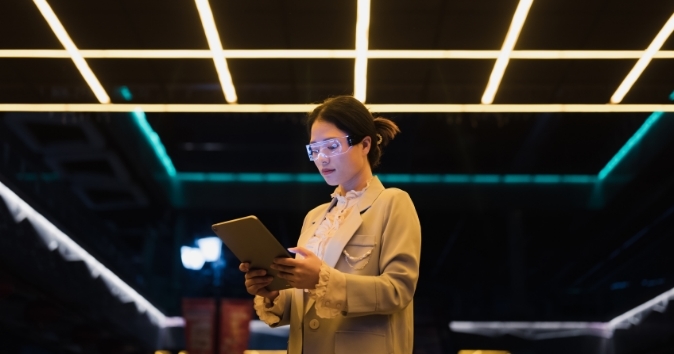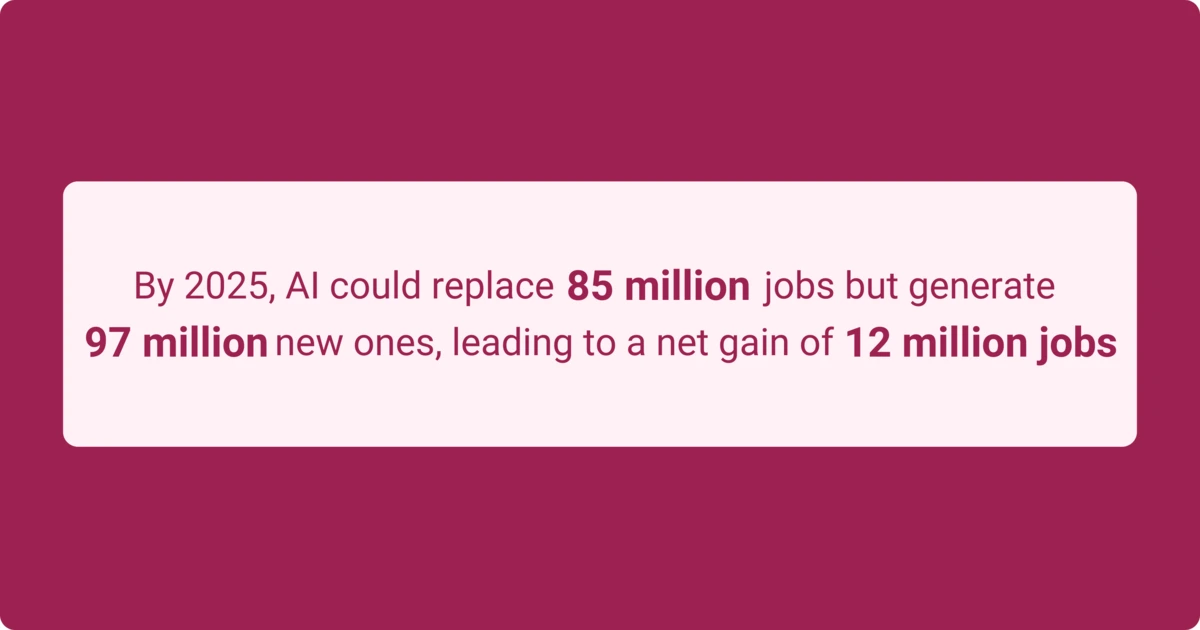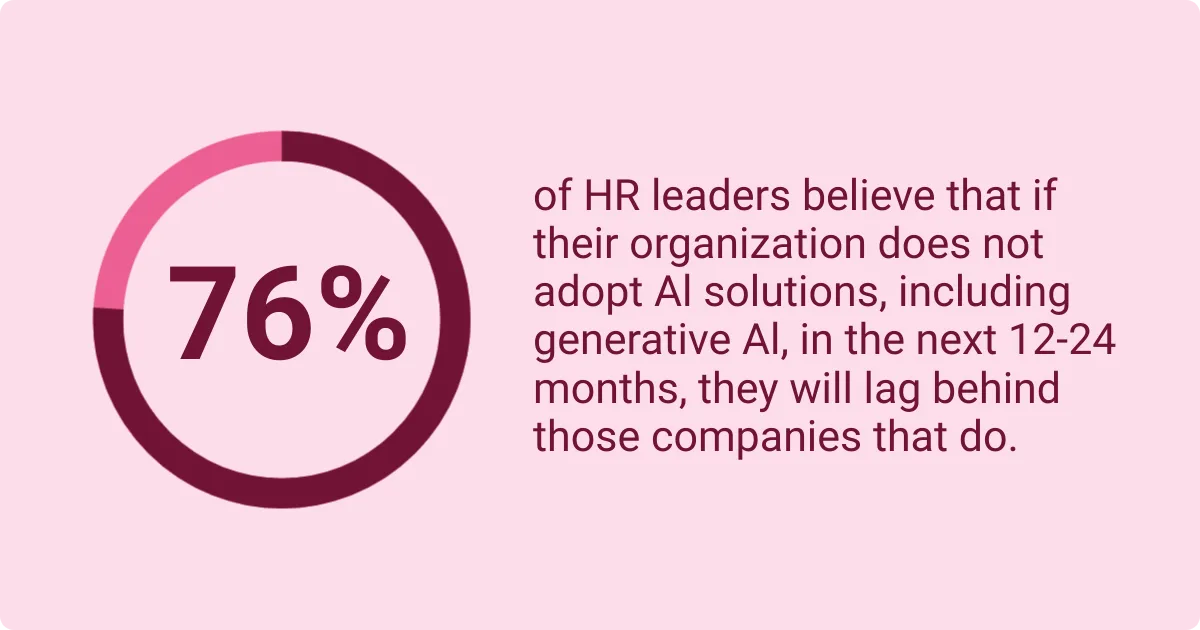AI and the Future of Work: How Emerging Technologies Are Reshaping the Workforce

As 2025 takes shape, the question on every executives' and employees' mind is: how will AI change the future of work?
AI tools have already taken hold and show no signs of stopping. According to McKinsey's report, "The State of AI in Early 2024: Gen AI Adoption Spikes and Starts to Generate ValueOpens in a new tab", 65% of organizations are using generative AI, and 72% of organizations report overall AI adoption.
The impact on jobs and recruitment is already being felt. A Deloitte survey, "Generative AI and the Future of WorkOpens in a new tab", found that skills-based organizations are 107% more likely to place talent effectively and 98% more likely to retain high performers with the use of generative AI.
As AI technologies and the adoption of automation continue to evolve and organizations continue to ponder and test AI use cases, so too does the question of AI and the future of work. Let's explore how AI algorithms are already at work, how generative AI might change how we work, and how to deploy AI ethically and sustainably.
Types of artificial intelligence at work
AI can complement a variety of roles due to the variety of AI tools available. Methodologies in the AI workforce include:
Generative AI
Generative artificial intelligence (gen AI) generates text, images, video, code, and other digital artifacts based on prompts. ChatGPT is one of the most well-known forms of gen AI. It can help produce documents, graphics, and more.
Natural language processing (NLP)
NLP is characterized by the use of computers to understand human language to identify patterns and sentiments. NLP can play a role in identifying employee sentiment based on survey responses or summarizing meetings.
Machine learning
This kind of AI uses algorithms to identify patterns and make predictions based on past behavior. It is an adaptive technology that learns as it intakes new data. It can be built to flag errors, automate chatbot responses based on queries, or personalize a web experience based on previous behavior.
Predictive analytics
Predictive analytics produces a similar output to machine learning, but instead of relying on an algorithm, it employs predictive models. It analyzes data to identify patterns and make predictions. Tools like predictive analytics for HR can identify trends, strengths, and areas for improvement. They can provide cause-and-effect theories for these patterns or offer guidance on solving anticipated problems.
The rise of AI-driven skills and jobs
AI isn't merely poised to change the world of work as we know it – it already has. A report based on the U.S. Bureau of Labor Statistics found a 35% year-over-year increase in AI job vacancies. Another press release, "U.S. Bureau of Labor Statistics April 2024 Jobs Report and AI Job GrowthOpens in a new tab"by Veritone, backs the same data
An article by Statista, The Double-Edged Sword of AI: Will We Lose Our Jobs or Become Extremely Productive?Opens in a new tab estimates that 25% of today's jobs will change between 2024 and 2027, with automation likely to have the greatest impact in office and admin support, legal, architecture/engineering, business and finance, and sales sectors."
The labor market is shifting, too. The rise of new-collar jobs is creating a new faction in the workforce. These folks may come from traditional blue-collar backgrounds and train via vocation or boot camp to obtain technical skills necessary in today's tech-driven world rather than via a traditional four-year degree.
This alters the labor market to enable new-collar workers to enter industries previously unavailable to them as the market shifts to value skills over degrees.
While these shifts are more significant, there are smaller changes happening, too. Roles are evolving to accommodate new skills revolving around AI fluency. There isn't just demand for AI system trainers and algorithmic experts; those whose jobs could benefit from automation will need to upskill to know how to best take advantage of all these new tools.
Countless roles stand to benefit from the productivity gains that AI can facilitate. HR managers can generate job descriptions and build screening algorithms to find ideal candidates faster. Project managers can build reports in a moment's time to gauge progress. And people managers can use AI-driven tools to gauge engagement and much more.
All of this potential sounds exciting, but there's a lot to content with, too. Companies need to decide exactly how they will employ AI, how to train employees to upskill as needed, and how to ensure all of the above is done in an ethical fashion.
And then there is the perennial question: will AI replace jobs?
Will AI replace jobs?
Since ChatGPT and AI as we know it burst on the scene in 2022, people have been anxious about how it may replace jobs. In the wake of the Great Resignation and mass layoffs, this is a fair concern.
The World Economic Forum estimates that, by 2025, AI might eliminate 85 million jobs but create 97 million new ones, resulting in a net gain of 12 million jobs.

But let's dig deeper beyond the estimated numbers.
AI is likely to streamline operations and create productivity gains primarily through a skills shift rather than job replacement. Generative AI and automation will replace tasks rather than people.
This will enable people to take on more complex roles while repetitive tasks can be relegated to AI, freeing employees up to focus on creativity and strategy instead.
However, it is undeniable that some roles and some people will be displaced. Consider an existing technology like self-checkout. There are still plenty of store employees but probably not as many as there used to be – just enough to monitor the self-checkout and, if necessary, man the traditional checkout lines.
While automation might not completely wipe out roles, it will likely reduce the necessary head count.
Companies must anticipate these kinds of shifts and create a plan for any potential displacement. Employees aren't oblivious to the potential changes. Thus, their organizations must strive for as much transparency as possible as new technologies are integrated and roles begin to change.
Keeping up in the age of AI
If workers and leaders alike don't upskill, all the potential gains of AI are lost to wasted hours of confusion and misuse (or total ignorance).
Gartner found that 76% of HR leaders believe that if their organization does not adopt AI solutions, including generative AI, in the next 12 to 24 months, they will trail those companies that do.

Organizations can only be as prepared as their employees are. Thus, they must embrace mass upskilling in order to keep up with the rapidly evolving technology – and to take advantage of the potential gains in productivity.
Here are a few ways to ensure your organization doesn't get left behind with generative AI and the future of work:
1. Create a culture of continuous learning and upskilling
Gallup-Workhuman research found that nearly half (47%) of organizations that have begun to implement technology offer no formal or informal training opportunities. Yet employees are ready and willing to upskill – they just need the resources and opportunity to do so.
The same research uncovered a concerning gap between leaders and other employees: 41% of individual contributors haven't learned a new skill in the last one to two years. Leaders are far likelier to receive AI and other tech-related training than others.
And senior leaders are more than 2x as likely as managers, project managers, and all other individual contributors to strongly agree they see a path to grow within their organization.
Adopting a growth mindset and a culture of continual learning is the only way to survive the future of work in America and beyond. But this isn't possible without organizational support.
Organizations must establish training programs and set clear expectations for workforce development and the adoption of generative AI. By leveraging AI tools for training and development, they can create an organized, structured plan for AI integration and share it with employees, outlining how they will be prepared for this new era.
One of the best ways to foster a culture of learning is through employee recognition. Sending recognition for upskilling shows employees that their efforts are valued and that upskilling is important to the organization.
The Workhuman platform makes recognition easy from the start. The latest innovations enable managers to automate welcome awards as a means to introduce employees to recognition and the broader culture of appreciation. From there, it's easy to send recognition for everything from a career or personal milestone to a new certification or AI development.
Other automation technologies are embedded within the platform, generating spur-of-the-moment overviews into employees' skills, engagement, and more. See how the platform can work for you here.
2. Establish AI ethics
Generative AI has the potential to transform workplaces – and cause a lot of issues without careful consideration. If you haven't already, your organization must establish a code of AI ethics to account for the ethical use of AI, address biases in algorithms, protect data privacy and intellectual property, and ensure fairness and accountability.
Adoption of automation technologies and AI for work activities is not something to be taken lightly.
3. Use AI as a collaborator
It's important to view AI tools as enhancing rather than taking away. Artificial intelligence is here to serve as a complement rather than a detractor. It should free up people to focus on more human tasks like creativity and strategy and take monotonous, repetitive tasks off their plates. However, many workers will need education to understand how technology may impact their jobs and how they can benefit from AI in their specific roles.
Use this framework to generate excitement around automation and AI, rather than fanning fear and anxiety:
4. Embrace a growth mindset
AI is forcing us all to become more comfortable with change. Employees will need to learn new tools and establish new workflows. Instead of denying reality, strive to embrace this. Talk openly about new tasks and tools with employees. Share your personal struggles and triumphs with new integrations.
Discuss how these tools can augment your workflow and what obstacles you've encountered. No one expects it to be a completely smooth process, so honesty and transparency can go a long way to make employees more comfortable with all the changes.
Concerns about AI in the workplace
There is no denying that there is an urgent need for organizations to establish their own boundaries and expectations around AI. The power of these rapidly evolving tools is still revealing itself, but it's clear that strict business practices, ethical codes, policies, intellectual property, and more are necessary to keep it under control.
AI has the potential to impact privacy and surveillance, national security, disinformation, intellectual property, resource consumption, and more.
It's easy to see why companies feel such pressure as these technologies continue to evolve:
Currently, there are few guidelines or codes of conduct for how companies should ethically implement AI with respect to their workforce. At the same time, many companies, especially those publicly traded or aiming to go public, feel intense pressure from competitors and investors to adopt AI to save on labor costs and increase efficiency. - Brookings
A core issue is that many don't know how algorithms or AI tools work. When it comes to generative AI, for example, what these tools generate has to come from somewhere. So, where are they getting their base data and training? Who needs to ask consent and of whom?
The National Fund for Workforce Solutions encourages a systems-thinking approach, saying:
Beyond thoughtful policy interventions, there is an opportunity for employers, education institutions, and philanthropy to work together to build supportive services to help those in need during transitions between jobs or careers. Using a systems-thinking mindset, and engaging a cross-cutting coalition of committed partners, we can create new pathways to success for workers, while simultaneously benefitting from increased automation in our workplaces.
Then there's the issue of trust. Both employees and employers want to know that the other party is using AI in responsible ways. Employees want to know that their intellectual property is cared for and employers want to know that their employees aren't taking credit for work that isn't theirs.
Clear, transparent AI use guidelines are the solution to this. Again, AI adoption is not going to be smooth sailing all the way through, but with consistent communication, its impact is bound to be a lot more positive.
Closing thoughts
AI may be shaping the future of work, but many questions remain. The best way to prepare for the age of automation and generative AI is by prioritizing education and communicating openly about new AI tools and program adoption. In the face of so much change, it can be easy to get caught up in the shiny new tool and pressure to perform.
Remember, we are ultimately all in it together as we learn the benefits of generative AI and evolve alongside one another.